
23 minute read
UNIT 1: World Cup fever
UNIT 1: World Cup fever
LEARNING OBJECTIVES
Reading and Viewing:
1. Comprehension – types of texts, compare texts. 2. Work out the meanings of unfamiliar words. 3. Answer comprehension questions from low order to high order. 4. Identify features of the text. 5. Understand visual texts: Cartoons.
Language Structures:
Understand the meaning and use of punctuation marks in texts.
Listening and Speaking:
Complete an assessment task on a listening comprehension.
Writing and Presenting:
Write, edit and present an essay for an assessment task.
INTRODUCTION
This unit is designed to practise reading and viewing skills, as well as understanding and being able to use language structures in context. By now, you should be familiar with all language structures, as well as verbal and visual texts; it is a matter of practising your skills.
Vocabulary development is an important factor of being able to decode texts effectively; so reading the passages provided and discussing the texts (“World Cup Fever”, “Bookshelf” and the visual texts), forms an important part of (a) development of vocabulary in making meaning of texts and unfamiliar words; as well as (b) allowing you the opportunity to express your opinion and responses to texts.
To understand the satire in cartoons, you need to have some knowledge of current affairs. This and the understanding of the verbal texts means that you must try to read as widely as possible not only the set works, but also newspapers, novels, short stories, and texts on the Internet.
IMPORTANT TERMINOLOGY
Not new, but may need revising! All of these can be found in the glossary provided in Addendum C.
Figures of speech: e.g. metaphor, rhetorical questions, pun, etc. Features of texts, e.g. style, diction, genre, satire, irony Advertising terms: slogan Features of visual literacy, e.g. font, caricature
LESSON 1: Reading and viewing – comprehension (1)
DEFINE
Refer to Addendum D (Terms used in Comprehension and Literature Questions) and style and diction in the glossary (Addendum C).
Read and discuss the comprehension texts. Remember that you are practising your reading and viewing skills (if you are an auditory learner, it will really help if you read aloud).
Note that TEXT TWO is a visual text – again, discuss the texts, and don’t simply use them to answer the questions.
Answer the questions and have it checked against the memorandum. Discuss any answers with your facilitator if you’re unsure.
TEXT ONE
WORLD CUP FEVER
How a schoolboy created rugby
The town of Rugby has put up a statue in his honour and erected a memorial stone with the inscription: “This stone is in honour of William Webb
Ellis who, with fine disregard for the rules of football, picked up the ball and ran with it. AD 1823.”
2 Opposite is an enormous field, flanked by trees on one side.
According to legend it was here, on
Rugby school’s playing field, where the game was born the day 14-yearold William’s naughtiness disrupted a soccer game. 3 The 1999 Rugby World Cup tournament kicked off in Cardiff, Wales about two hours’ drive from Rugby. If William Webb
Ellis were able to attend would he even have recognised the game? 4 The soccer game he and his friends were playing that day in 1823 wasn’t soccer as we know it today. It didn’t have 11 players a side, a goal net and a goalie. It was far more primitive, played by 40 or 50 boys at a time. 5 “Players could pick up the ball,” says amateur rugby historian Clive Jones, “but they could run only backwards with it, not forwards.” 6 Clive, a former teacher who works part time for the Rugby tourism association, has been researching the origins of the game for years. He believes Webb Ellis was the first to run forward with the ball –the distinguishing characteristic of modern rugby. 7 Dr Danie Craven, who also researched the game’s history, believed the game developed from a primitive sport played in
Roman times. 8 Doc visited Rugby for the first time in 1931.
“Now I’ve seen the memorial to William
Webb Ellis,” he wrote. 9 “But for me, picking up the ball isn’t the most important thing. People often picked up the ball in the game from which rugby, soccer and hockey developed.” 10 It took a long time before rugby authorities could be convinced a World Cup would be to the advantage of the game. 11 In 1985, the world’s seven largest rugby unions – England, Australia, France,
Wales, New Zealand, Scotland and Ireland – decided to play the first World Cup in 1987. Because of apartheid, South Africa was banned from international rugby at the time.
It was decided in 1985 to name the World
Cup trophy after William Webb Ellis.
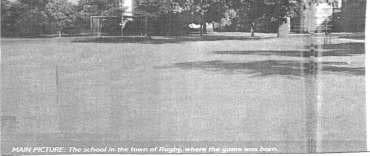
TEXT TWO: The Sportal Network advertisements
ACTIVITY 1: Comprehension
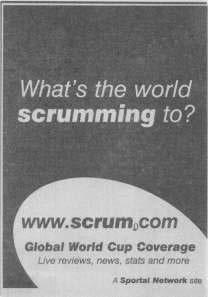

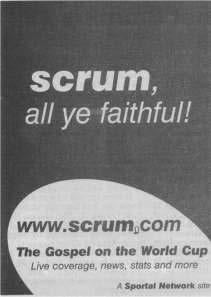
Study TEXT ONE on the previous page: How a schoolboy created rugby
1. In your own words, explain how the game of rugby got its name. (2) 2. Explain the metaphor in the title of the article, and comment on its effectiveness. (4) 3. Suggest the purpose of the rhetorical question that ends paragraph 3. (2) 4. Refer to paragraph 3: “The 1999 Rugby World Cup tournament kicked off in Cardiff, Wales.” Explain the wordplay (pun) in this sentence. (2) 5. What does the word amateur (paragraph 5) contribute to your understanding of Clive Jones’s involvement in the history of rugby? (1) 6. Refer to paragraph 6. According to Clive Jones’s research, what important word is missing from the inscription in paragraph 1? (1) 7. Identify the style of this article by examining the diction and say how the use of the first person and contractions contribute to this style. (6)
Study TEXT TWO: The Sportal Network advertisements 8. In the headline for each advertisement, the advertiser makes use of wordplay. Explain how the slogan fits in with the wordplay in each case (e.g. in the first one, the word “Global” in the slogan echoes the “world” in the headline). (2) 9. Most advertisements make use of a picture to create impact. Comment on whether this has been applied in TEXT TWO. (3) 10. How does TEXT TWO link up with the title of TEXT ONE? (2)
LESSON 2: Listening and speaking
Strategies for better listening during comprehension
Listening is the one skill that you should use the most in everyday life. Listening comprehension is the basis for your speaking, writing and reading skills. To train your listening skills, it is important to listen actively, which means to actively pay attention to what you are listening to.
You should know that there are different types of listening: Listening for gist: you listen in order to understand the main idea of the text. Listening for specific information: you want to find out specific details, for example key words. Listening for detailed understanding: you want to understand all the information the text provides.
Tips to improve your listening skills before you listen
Think about the topic of the text you are going to listen to. Think about what type of text you are going to listen to. Relax and make yourself ready to pay attention to the listening text.
While you are listening
It is not necessary to understand every single word. Try to ignore those words that you think are less important. If there are words or issues that you don’t understand, use your general knowledge as well as the context to determine the meaning. Focus on key words and facts. Take notes to support your memory. Intonation and stress of the speakers can help you to understand what you hear. Try to think ahead. What might happen next? What might the speaker say, which words might they use?
After listening
Think about the text again. Have you understood the main points? Review your notes. Check whether you have completed your task correctly.
Adapted from: www.learning-english-online.net/skills/listening-comprehension/listeningstrategies/
LESSON 3: Writing and presenting
TIPS
Writing an essay
Some notes adapted from the CAPS document to help you:
Remember that essay writing is a process. During the writing process, candidates are expected to do the following: Planning/Pre-writing o Decide on the purpose and audience o Determine the required format, style, point of view o Brainstorm ideas by means of mind maps/flow charts, etc. Drafting o Use main and supporting ideas from the pre-writing o Produce a first draft, taking into account purpose, audience, topic, genre o Determine word choice – use appropriate, evocative words and expressions to make writing clear and vivid o Adapt language and tone to suit audience and purpose. Editing Proofreading o Define word choice, sentence and paragraph structure and add if necessary o Evaluate content, style and register o Use appropriate and accurate punctuation, spelling and grammar o Prepare the final draft. Presenting
The following types of essays may be written. Please note that the question paper will no longer prescribe what type of essay you have to write for a given topic. Some topics lend themselves to one or two particular types of essays, but the interpretation is left entirely up to you.
Narrative: Telling a story – it provides a sequence of events and reasons. How did it happen? When did it happen? Use a story line that is convincing.
Descriptive: Details are given within a specific time and setting. Impressions become known to the reader, as they are experienced by the narrator. Rather like a snapshot, a descriptive essay allows the reader to experience the situation, usually by means of sensory imagery. This helps us to see, hear, smell, taste and feel it (whichever is appropriate).
Reflective: Tends to be personal. Presents the writer’s views, ideas, thoughts, and feelings or memories; usually something he/she feels strongly about.
Argumentative: Present an argument for or against an issue. States the writer’s point of view, with reasons, to convince the reader in one way or another. Evidence is given for the truth of any statement.
Discursive: Presents a more balanced view of a particular argument, presenting various sides. Tends to be objective and the argument is presented in a reasonable way. The conclusion should make the writer’s point of view clear.
Response to a picture: In this essay, any type of essay can be written, but there must be a clear link between the picture and the topic (e.g. if the picture features a teenager holding a key, the essay cannot just focus on adolescence without taking into account the key (e.g. new opportunities, responsibilities) – and the connection must be evident in the essay somewhere.
LESSON 4: Language structures – Punctuation
Punctuation affects meaning: It either makes meaning clear, or in the case of literature, creative work or speaking (use of pauses, emphasis, etc.), it enhances meaning.
You need to know: a. how to use punctuation correctly and effectively; and b. how to appreciate nuances in texts by understanding the functions of punctuation marks.
Full stop
Also called period (in American English). Use a full stop at the end of a statement. Use it at the end of an abbreviated word: Jan. Feb. Mar. o But no full stop when it is pronounced as a word: FIFA, UNISA, UNESCO o Nor if the last letter of the abbreviation is also the last letter of the word: Mr, Mrs Use only one full stop at the end of a sentence, even if the last word is an abbreviation that must have a full stop: I will bring your books, papers, notes, etc. Use three full stops for words omitted in the middle of a quotation –called ellipses.
Comma
Indicates slight separation or pause between a list of adjectives, adverbs, or nouns in a sentence. o His sane, sensible remark was met with disgust, contempt and bad manners. o We shall have fruit, vegetables, grains and some poultry. Separating phrases and subordinate clauses from main clauses. o Winking at me, he made a witty remark. (Participial phrases) o Although she is disappointed, she is smiling sweetly at her host. o Samantha sent her friend a text message, which was designed to cheer her up. In pairs, they mark off words, clauses or phrases from the rest of a sentence (Additional information). o Her arrangement, original and interesting, attracted a lot of attention from the judges. (Parenthesis) o Phillip, for example, had to do the test a second time. (Sentence adverb) o Henry, will you please open the door? (After the name of the person who is addressed) Separate introductory words from the sentence: o Henry, will you please open the door? o Well, I don’t think I’ve ever seen that before! Before some conjunctions (such as but, or, and), when they are separating main clauses: o Jack wanted to try out his new kite, but there was no wind. o Pierre had booked his flight online, and did not know that he should also make a visa application.
Where commas should NOT be added
In pairs for a non-restrictive adjectival clause: o Medical professionals, who do not wash their hands, are a menace to all patients. (All medical professionals are accused of not washing their hands.) o Medical professionals who do not wash their hands, are a menace to all patients. (Correct) When using a negative in the main clause, combined with conjunctions such as because, or as, in the subordinate clause. o I was not worried about the examinations, because I had been warned that they would be very difficult. (This would be an irresponsible, illogical thing to do.) o I was not worried about the examinations because I had been warned that they would be very difficult, but rather because I could not find my notes to study. (Correct)
Where commas MUST be used to prevent ambiguity
Participial phrases o Dorothy having mistaken me for the waiter called and waved at me. (Did the waiter call and wave at me?) o Dorothy, having mistaken me for the waiter, called and waved at me. (Correct) Ambiguity o Helping at the annual fête was the spring queen who served tea and scones and her two princesses. o Helping at the annual fête was the spring queen, who served tea and scones, and her two princesses. (Correct)
Colon
Introducing direct speech. o John explicitly stated: “I will not be the victim again.” Separation of two co-ordinate clauses when no conjunction has been used. o They prepare well: the journey is long. o The loyal will be honoured: the disloyal will be shamed. Introducing a list. o Mary had quite a few animals: a little lamb, a chicken, a parrot and a boyfriend. Introducing subsections in regulations, conditions, etc. o If a delivery cannot be made within three days: the client will be notified telephonically a ten percent discount will be given, and there will be no handling charges
Semicolon
A stronger break than a comma, but not as final as a full stop.
Where clauses in a sentence are not joined by a conjunction. o When holding the violin, the back must be straight; turn your head to the left and hold it by the weight of your head; never use the neck muscles. Antithetical clauses (the one is the antithesis of the other). o Our shoes are broken; our hearts mended. When using sentence adverbs such as however, therefore, in this way, for instance, thereupon. o She does not know the way; however, she will get there with her new GPS. When items are listed with special details for each item (a complicated list).
o Take in enough of the following: water, either filtered or from a spring; vitamin C, at least 1 000 mg per day; calcium citrate, sufficient for your personal needs.
Hyphen
Links words to form compounds. o Mother-in-law, mock-charge When a word is broken to continue in a next line. Indicating the new syllable when the previous one ends with the same letter as the opening letter of the next. o Co-operate, pre-eminent To distinguish between different meanings of the same word when one uses a prefix. o Recreation is important for your health. The re-creation of this musical is an improvement on the previous one. Certain prefixes are linked to nouns by a hyphen: anti-, pre-, ex-, de- and pro-. o De-toxification agent, anti-war campaign Avoiding ambiguity. o Pickled-asparagus salad (the asparagus is pickled, not the salad) Linking certain phrases. o Delmas-Bapsfontein road, Anglo-Boer War
Question mark
Questions always end with a question mark. Sometimes expresses uncertainty, e.g. about an exact date, or year of birth. o You said it would snow tomorrow?
Exclamation mark
Used after an individual exclamation or interjection. o What a performance! Used to indicate emotion or tone o The Sergeant yelled, “Attention!” o “I was rooted to the spot!” whispered the terrified woman. Use exclamation marks sparingly. Overuse is a sign of bad taste and makes it less effective. Never use exclamation marks in pairs. (!!)
Inverted commas
Indicate direct speech. o “Please check my emails in the morning?” he asked his new secretary. Question marks and exclamation marks are included in the inverted commas. o “Would you like more tea?” she asked. Used to indicate disagreement with the chosen term: o She couldn’t come because she was too “busy”. Used to excuse oneself when using slang. o It was a huge “schlepp” to get the garage clean on time! Quotations from another author’s work. o The pain matrix is “a set of brain regions that become active when people experience pain …” Sunday Times Lifestyle – 14 May 2006
Dash
Single dash: For indicating abrupt changes in opinion or thought. o I saw my doctor yesterday — but I’ll tell you everything when we meet for lunch. Pairs of dashes: Used in the same way as commas or brackets for parenthesis
Brackets
In the same way as a pair of commas, for parenthesis
Square brackets
Indicating your own added words, that are not those of the author. o Salieri reports that Antonio has told Bassanio not to “slubber [Bassanio’s] business for [his] sake ...” When something is not explicitly stated, but only implied, square brackets are used in the explanation. o [John] Hurry! We must catch him before he leaves.
’s
Apostrophe
Where letters are omitted in contractions. o Isn’t, wasn’t, one o’clock, a song of the ’eighties (nineteen eighties) Possessive forms. o The parson’s book, Angus’s coat (singular). o A ladies’ size, the old boys’ club (plural). NB An apostrophe is NOT used for possessive adjectives and possessive pronouns: o The cat cleaned its whiskers; Whose book is that? The decision is hers; This book is yours. Apostrophes are NOT used in plurals (except for the exceptions mentioned below). o Grade 12s experience a lot of pressure; Shakespeare was born in the 1500s. Only in certain plural forms of letters to avoid ambiguity. o Know your p’s and q’s
NB The position of the apostrophe in possessive case
If the owner is singular, we add ’s: The family’s car; the boy’s school; EVEN IF the owner’s name ends in an “s”: Marcus’s pet hamster; Mr Jones’s farm. If the owners are plural, we add only ’: The boys’ school (school of many boys); the bosses’ rules (rules of many bosses); the Joneses’ farm UNLESS the owners in the plural have no “s”: The people’s hero; the children’s playground.
In the case of a biblical or classical name ending in “s”, we simply add ’: Moses’ laws, Hercules’ strength; Rameses’ temple
FOR THE CURIOUS
See how punctuation changes the meaning completely for the following:
A woman without her man is nothing A woman: without her, man is nothing!
Read and discuss the passage “Bookshelf” after you have carefully studied the function of punctuation marks. Then complete the activities.
ACTIVITY 4
Read the passage below and answer the questions that follow.
Bookshelf
If you’re into South African humour, you could do worse than to browse through Hau, my broer, old chum! edited by Khotso Kekana. This anthology is a monument to the new South Africa which has come to terms with the past and can laugh irreverently at the politically correct present (not recommended for the politically thinskinned, however).
Packed with entertaining – and yet pertinent – material, it is a light-hearted joyride through the troubled waters of our oh-soseparate past into the yet-to-be-charted territory of our Simunye future. A relaxing bedside read or a supper table talking point, it contains a variety of material: anecdotes of our not-so harmonious past which are retold with satirical relish; cartoons which cover the entire spectrum of our rainbow nation; and jokes which give the finger to prejudiced people of all hues.
Let me whet your appetite with one of its gems (an authentic story told by a passenger on a Pretoria-bound taxi):
A Boer stopped at a well-known filling station in Gauteng, on his way to Vredefort in the Free State. He handed his keys to the petrol attendant with the words, “Goeiemiddag. Maak vol asseblief.” (Good afternoon. Fill up, please.) The attendant arrogantly peeped over his dark glasses and said, “How much?”
“Vol asseblief,” repeated the Boer.
“Sorry, I only speak English,” was the dismissive reply.
Momentary silence.
Then the Boer smiled and broke out effusively: “English! No problem! Good day, sir. I am presently experiencing a profound desire to replenish the propellant of my chariot. Therefore, I cordially request you to transfer from your subterranean reservoir a sufficient supply of combustible liquid of the highest octane to fill the appropriate container in the said means of perambulation to the brim.”
Hau! Ek sê, my broer – hy’t hom gas gegee, maar ek weet nie of hy dit gekry het nie! (Untranslatable)
Available in local bookstores from 8 February, the collection is a steal at R39.99 (VAT included).
Alternatively, log on to salit@kalahari.com; they have a promotion on local literature until the end of February. Kate Devlin
State the function of the following punctuation marks as they appear in the passage: 1. The apostrophe in line 1. 2.1 The italics in line 3. 2.2 Suggest an alternative method of punctuation here. 3. The comma in line 9: (“… thin-skinned, however”). 4. The dashes in line 12 – 13. 5. The hyphens in lines 13–15. 6. The italics in line 16. 7. The colon in line 19 (“… contains a variety of material: …”). 8. The semicolons in lines 21 and 22. 9. The comma in line 34 (“… petrol attendant with the words, ‘Goeiemiddag,’ …”). 10. The brackets in lines 35: (“Good afternoon. Fill up, please.”). 11. The capital letters in VAT (line 66). 12. The semicolon in line 69 (“… kalahari.com; they have … “). 13. The full stop in line 69 (“kalahari.com”).
More punctuation practise
14. Add inverted commas to this sentence:
You must complete the course of antibiotics the doctor explained or you will not recover from the infection. 15. Punctuate the parenthesis in this sentence:
Mrs Buthelezi the new Zulu teacher arrives at our school tomorrow. 16. State the function of the hyphen in the following sentence:
A farmer stopped at a well-known filling station in Gauteng, on his way to
Vredefort in the Free State.
LESSON 5: Language structures – The apostrophe
The apostrophe is often used incorrectly and required special attention. The core content is found in the notes for Lesson 4 (Punctuation). Go over these again and then do the activity.
Focus on the apostrophe in the punctuation notes and complete the activity.
ACTIVITY 5: The apostrophe
Evaluate the use of the apostrophe in each sentence below (i.e. state whether it is correctly used or not, giving reasons):
1. The girls’ tennis teams won all their matches. 2. It’s funny how the cat always plays with it’s tail. 3. The Joneses live next door. 4. Jack Jones’ dog is a Labrador. 5. Who’s the new man in your life? 6. She does’nt know how to windsurf. 7. Who’s CD is this? 8. You’re the only one I can trust because I’ve seen so much evidence of your integrity.
Quick summary of what you should know:
Cartoons: 10 marks – figures of speech (e.g. pun), satire, visual conventions, e.g. body language, drawing techniques, impact of font, layout of pictures and text, perhaps direct and indirect speech.
TIPS
As we know, cartoons are humorous pictures, sometimes in a single frame, while cartoon strips may tell a story. The objective is to entertain, and also (importantly) to satirise. You have to keep up to date with current affairs in your country and the world to understand the satire in a cartoon. Watching the news and reading online or broadsheet newspapers and cartoon books (e.g. Zapiro, Madam & Eve) is good preparation
Techniques of cartoonists
Visual conventions and drawing techniques that convey body language, facial expression and actions; impact of font; speech/thought bubbles. Pun Irony Caricature
When analysing the visual aspects of a cartoon, it is essential to give the specific detail: e.g. don’t simply say, “She’s angry – as we can see in her body language/facial expression”, but do say, “She’s angry – she has her hand on her hips and is leaning forward aggressively. She has frown lines and her mouth is wide open to show that she is shouting.” Let’s look at a cartoon which is in keeping with the theme of the comprehension you did earlier. The questions are based on Zapiro’s cartoon: Game Plan.
ACTIVITY 6: Game Plan cartoon
This cartoon appeared in the Pretoria News, 16 July 2005
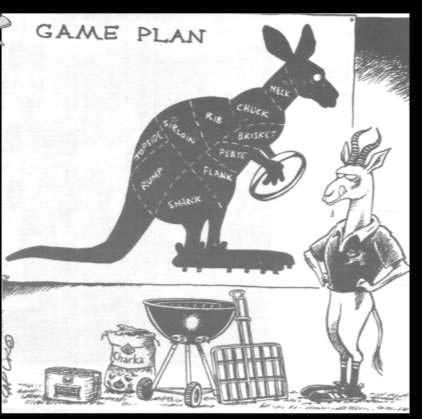
1.1 The cartoon refers to a specific 1999 Rugby World Cup match. 1.1.1 Who are the opposing teams? 1.1.2 Explain how this information is conveyed by the visual elements in the cartoon. (2)
(2)
1.2 The message of the cartoon is conveyed in metaphor. What is the message? (2) 1.3 Examine the dictionary extract provided below to establish the meaning of the word “stereotype” and then explain what stereotypes of South Africans and/or rugby fans are evident in the cartoon. ster·e·o·type /stérree ə ə n. & v. • n. 1. an oversimplified standardised image of a person or group. • v. to categorise
individuals or groups according to an oversimplified standardised image or idea. (2) 1.4 Explain the pun in the title of the cartoon. (2)
[10]
2. Now read and enjoy the cartoons. Spend some time looking at the visual elements (body language and facial expressions of the characters, interaction between characters, speech/thought bubbles, and the way the font has been printed/punctuation which gives clues to hidden meaning.
2.1 Comment on the irony in the cartoon. 2.2 Which visual clues indicate that the public servant in the image deserves the accusation that is made in the newspaper headline?
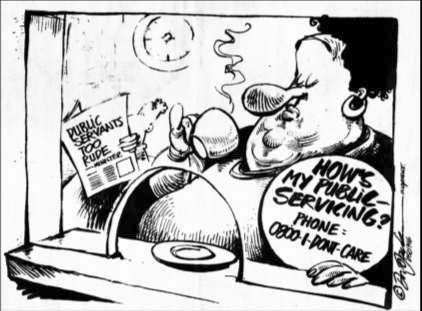
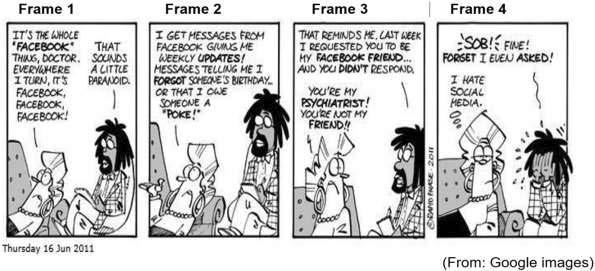
MADAM & EVE
3.1 Study frames 1 and 2. How has the cartoonist portrayed Madam’s emotions in these frames?
3.2 In frame 3, bold print is used in Madam’s answer. What does this imply? (1)
3.3 Is Madam speaking in frame 4? Justify your answer. 3.4 Discuss the irony used in the message of this cartoon. (2) (3)
FRAME 1 FRAME 2
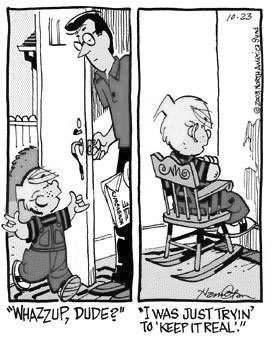
DENNIS THE MENACE
4.1 Dennis’s expression in the first frame, “Whazzup, dude?” is an example of what type of language? (1) 4.2 In the first frame, Dennis comes across as being quite confident. How is this portrayed? (2) 4.3 Rewrite Dennis’s words in the first frame in more formal language. (1) 4.4 Why, in your opinion, was Dennis given a “time out”? (2) 4.5 Why does tryin’ end on an apostrophe? Explain why it is appropriate here. (2)
LESSON 7: Listening and speaking – Oral: Prepared speech
Refer to the portfolio book for the task instructions.


